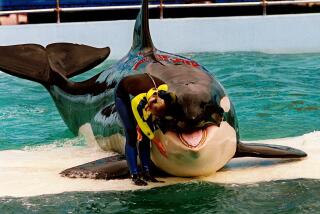Dr. John Lilly, 86; Pioneered Study of Dolphin Intellect
- Share via
Dr. John C. Lilly, a neurophysiologist who invented the isolation tank and pioneered research on dolphin intelligence and communication in a controversial career marked by his experiments with mind-altering drugs, has died. He was 86.
Lilly, whose Malibu home was once a gathering spot for counterculture figures such as Timothy Leary and Ram Dass, died Sunday of heart failure at Cedars-Sinai Medical Center.
A taciturn man with an impressive list of scientific achievements, Lilly first gained fame in the mid-1950s for developing the isolation tank.
He viewed the now-popular tank, in which users lie suspended in a dark box filled with warm saltwater and are isolated from external stimuli, as a way to examine human consciousness, and to induce states of reverie and waking dreams by taking what he called a “psychological free fall” into a “black hole in psychophysical space.”
In the late ‘50s, Lilly began conducting the first serious scientific studies of bottlenose dolphins, which he called “the humans of the sea.”
Lilly maintained that dolphins, which he considered smarter and more humane than humans, had made remarkable efforts to talk to researchers by imitating human sounds.
In his book “Communications Between Man and Dolphins,” Lilly said he discovered that dolphins “go to inordinate lengths to create sounds in the air that resemble those of human speech.”
But dolphins’ efforts to communicate, he believed, were hindered because there is only a narrow overlap between the frequencies of sound at which humans can hear and which dolphins can perceive.
Lilly and his wife, Toni, an artist, founded the nonprofit Human Dolphin Foundation to explore how man and dolphin can “talk” to one another.
In 1980, Lilly and computer scientists at the foundation designed a computer system called Janus--named after the two-faced Roman god--to work out a human-dolphin language.
Their research had convinced the Lillys that such communication is possible.
“The belief that man is the preeminent thinker, doer and feeler on this planet is denied by the investigations,” Lilly wrote.
It is narcissistic, he argued, for man to judge intelligence only by the areas in which humans have made accomplishments. The achievements of man such as planning structures or devising transportation, he said, should not be a measure of intelligence for dolphins living in the sea.
“Cut off from the need for building, for external forms of transport . . . they probably have very advanced ethics and laws, developed over millennia and passed on through sonic communication to their young,” he wrote.
Two of Lilly’s early books on dolphins--”Man and Dolphin” and “The Mind of the Dolphin”--addressed the exceptional brain of the bottlenose dolphin and spurred an interest in dolphins among many scientists and students in the ‘60s and later.
Louis Herman, director of the Kewalo Basin Marine Mammal Laboratory in Honolulu, was one of those students.
“Early on, Lilly made some fundamental discoveries about dolphins, particularly with respect to their vocalization,” Herman said.
“But his work on dolphin intelligence and dolphin language and so forth ended really in frustration for him. He could never achieve what he speculated about--that they had their own language.”
Herman, who has been studying dolphins since the late ‘60s, said that to those who met him, “Lilly conveyed an undeniable charisma and intellect.”
Born in St. Paul, Minn., Lilly was the eldest son of a successful banker and a wealthy stockyard heiress.
He graduated from the California Institute of Technology with a degree in biology and physics in 1938 and earned a medical degree from the University of Pennsylvania.
Lilly, who never practiced medicine, conducted research for the Army Air Corps during World War II on the physiology of high-altitude flying. In 1943, he received the John Clark Research Prize for his development of the electrical capacitance manometer, an instrument that measures the pressure of gases.
After the war, while doing research on brain electrophysiology, he developed the “bavatron,” a device for recording electrical activity over large areas of the brain’s surface and projecting it onto a screen.
In the 1950s, while at the National Institutes of Health in Bethesda, Md., he invented a technique that enabled scientists for the first time to take brain-wave recordings from the cortex of unanesthetized animals.
In 1954, wondering what would happen to the brain if it were deprived of all external stimulation, he created the isolation tank.
By 1961, he had resigned from the National Institutes of Health and had established a center in the U.S. Virgin Islands to study dolphins.
About the same time, Lilly’s continued interest in brain function led him to LSD. By 1964, he began mind-expanding experiments with the drug, which some observers say marked his first step off the deep end.
As recounted in “John Lilly, So Far,” a 1990 biography co-written by Lilly and one his disciples, Francis Jeffrey, during one experiment with the drug ketamine, he nearly drowned in the hot tub at his Malibu home.
The near-death experience, however, only confirmed to Lilly “that his life was guarded by higher powers in the extraterrestrial reality, a hierarchy of entities operating through the control of coincidence on a global scale.”
At one point, Lilly combined his experiments with psychedelic drugs, his research on communicating with dolphins and the isolation tank.
“During a session in an isolation tank, constructed over a pool where dolphins were swimming,” Lilly wrote, “I participated in a conversation between dolphins. It drove me crazy, there was too much information, they communicated so fast.”
Through the work of many scientists in the last two decades, according to Herman, much has been learned about dolphins.
These new studies, Herman said, have established that dolphins can indeed be regarded as intelligent animals.
Herman said that after Lilly gave up his work with dolphins, he was regarded by conservationists as favoring the discontinuation of laboratory studies of dolphins and oceanariums exhibiting dolphins.
But in a letter to the Maui News written only weeks before his death, Lilly argued that oceanariums were one of the few mechanisms for exposing millions of people to dolphins and for educating them about these animals and their need for protection in the wild.
Tens of thousands of dolphins die each year as a result of human activities, Herman said.
“To that end,” he said, “Lilly cared deeply about dolphins, and his plea and legacy is that we must continue contact with these animals in all forms available to us, for their good and for ours.”






